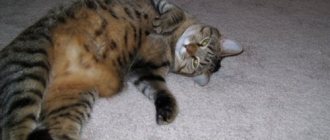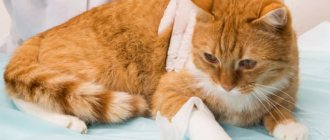Causes of appearance and main types of neoplasms
There are 2 types of lumps or bumps on the body:
- Benign. They pose a danger only when they reach large sizes. In this case, adjacent tissues are infringed and nutrition and blood supply are disrupted. Metastases of the lump of benign etiology do not occur.
- Malignant. Tumors consisting of degenerated pathological cells prone to metastasis. If a cat’s lump is cancerous or large, there is very little chance for the pet to recover and recover.
Most often, the formation is benign in nature; the following types are distinguished:
Most often, this formation refers to a lipoma.
- Hematoma. If a cat has a blue-violet hue on its head, hips, under the eye or on its back that causes pain when pressed, most likely it is a hematoma or bruise. The formation is caused by an injury in which small vessels are damaged; sometimes such a lump can fester and develop into a cyst.
- Lipoma. The subcutaneous wen in a cat is formed from adipose tissue, when pressed it does not cause discomfort, sometimes it rolls around inside. If a small lipoma grows, it is better to remove it.
- Cavernous hemangioma. Red bumps on the stomach, side and even on the butt, which do not cause discomfort to the animal, represent vascular growth of benign etiology.
- Syringoepithelioma. It is a modified element of the sweat gland. Often such a lump appears on a cat’s stomach. The seal does not cause discomfort and does not grow.
Other types of cones, less common
The following neoplasms are often found in cats:
Older animals are more susceptible to melanoma.
- Abscess. Occurs on the thigh, elbow or face due to a bacterial infection on damaged skin. The lump may be blue and fester, causing the cat pain, fever, and fever.
- Cyst. Often formed as a result of blockage of the sebaceous glands, they can appear on any part of the body - on the forehead, near the neck, at the base of the tail, on the paw. The growth is not prone to malignant degeneration and is painless.
- Melanoma. Growths in the form of moles. Often they are black, dark blue, brown. Mostly appear in old animals.
- Mammary cancer. First, a compaction forms in the area of the gland of the same name. But then the tumors spread to the entire body. The lump can be black, purple, and often bleeds.
Sometimes a ball-like tumor on the neck, under the jaw, in the ear, on the outer side of the thigh, under the armpit or in the spine area is a tick that has embedded itself and grown to a large size. In such a situation, the parasite must be urgently removed, but it is important to do this correctly so that the insect elements remaining under the skin do not lead to suppuration and the formation of an abscess. A lump on the pad of a front or hind leg may be a manifestation of a common paw disease called coronitis.
Causes of abscess in cats and cats
A scratch, a wound, a bite from another “roof neighbor” - any damage to the skin opens the door to infection. The smaller the injury, the greater the cat's risk of developing an abscess. This is explained simply. When the wound is open, the microbes that have entered it can come out along with blood or pus, and the animal recovers. A small surface of damage, especially a pinpoint one (like an injection), heals very quickly and is delayed. Foreign microorganisms that get inside remain alive. If the cat “fought” with another pet, was bitten or scratched, then the likelihood of infection with the subsequent occurrence of a purulent abscess is high. There could well be pathogenic microbes on the enemy’s claws or in his saliva. The problem is common, although there are not many causes of an abscess:
- The immune system comes into play; phagocytes and leukocytes flock to the site of invasion of pathogenic flora. Purulent contents form, but there is no way out (outflow). The site of this battle of microorganisms swells, swells, and a purulent abscess develops.
- An inflammatory process caused by dental disease. This happens from injury to the tooth by excessively hard food (for example, bone); age is also not the last factor.
- Secondary infection during treatment can also be the cause of the disease. Carrying out a medical intervention that violates the skin (injections, opening of abscesses) with non-compliance with sterility. An abscess in a cat can even occur at the injection site. Carry out all manipulations with a sterile instrument; animals are not insured against infection.
Symptoms
During an oncological process in the body, the animal is often irritated.
If the bump on the head of a cat or kitten is benign, then it is soft to the touch, rolls under the skin, and does not hurt or bother you when pressed. Internal malignant growths often appear as capsules that can be normal temperature or hot. A lump on the withers, on the side of the neck or on the mucous membrane in the throat from degenerated cells quickly increases in size. In addition, an adult cat or kitten develops the following symptoms:
- weakness;
- irritability or lethargy;
- digestive problems;
- refusal to eat;
- sudden weight loss;
- dyspepsia.
Flux (periostitis) in a cat: causes, symptoms, treatment
Basic information
In general, compared to dogs, cats are more prone to oral pathologies. This is due to the structure of their teeth. Most of them are long, sharp fangs. They do not have platforms for chewing and grinding food; cats only tear apart their prey and swallow its pieces without chewing.
For this reason, tartar quickly forms. It is an excellent launching pad for millions of bacteria. If the case is advanced, an inflammatory process begins, spreading first to the gums, and from there to the periosteum and tooth root. Roughly speaking, this is how flux occurs. In cats there are three forms:
- Periodontal abscess. This is a much more severe form of pathology, since it directly affects the tooth (more precisely, cement). If the process is started and the root is heavily involved, then you have to resort to surgical treatment methods. The tooth is then removed.
In addition, according to veterinarians, chronic inflammatory processes in the oral cavity are fraught with the development of diseases of the liver, kidneys and, especially, the heart. You shouldn’t joke with the health of your pets, and it would be better to be more attentive to your own teeth.
Symptoms
What are the symptoms? They are quite typical, since any person who has suffered from toothache at least once in their life has felt something similar:
- The first sign is often loose teeth and the appearance of blood on the toys the cat plays with.
- The animal's mouth smells very bad, which indicates that putrefactive processes have begun.
- The cat begins to feel ill, is reluctant to eat, and often refuses food altogether (during the period of exacerbation of toothache).
- If you look closely, you can see areas of swelling, redness, and brewing abscesses in the oral cavity. This is the most characteristic sign.
- Due to severe pain (with the development of pulpitis), the animal sleeps poorly, sometimes, for no apparent reason, it begins to growl, meow hoarsely and forcefully.
- Sometimes your pet's cheek becomes swollen (pictured). But, unlike human flux, this happens infrequently.
Therapy
Alas, if the process has gone far, under general anesthesia it is necessary to pull out the tooth and clean the dental alveoli from the remains of dead tissue. The animal is prescribed powerful broad-spectrum antibiotics (to prevent sepsis).
Diapers for dogs
Teaching a dog the command to Stand: teaching methods and basic mistakes
Diapers for dogs
Please leave a comment on the article. Your opinion is very important to us.
Scratching post: variety of shapes and types
How can you tell if your cat is sick?
Urolithiasis (UCD) in cats is not a death sentence
Shelter for cats
All materials published on the site are the intellectual property of the administration.
Any copying of materials is possible only with the installation of an active link to the source page!
For any questions you are interested in, you can contact us via
In general, compared to dogs, cats are more prone to oral pathologies.
This is due to the structure of their teeth. Most of them are long, sharp fangs.
Diagnostic methods
If the owner notices that bumps have appeared on the neck of a cat or kitten, it is necessary to urgently take the animal to the veterinarian. The doctor will conduct an initial examination and ask the owner about the pet’s behavior and whether any changes have been observed in its habits. Sometimes palpation alone is not enough to determine an accurate diagnosis. Therefore, a number of additional diagnostic studies are prescribed. Often these are cytological and histological analyzes that help determine the internal composition of the neoplasm and its nature.
Lump on a cat's chin photo
When a lump appears on a cat’s chin, pay special attention to the oral cavity. Very often, the presence of fistulas and other problems with the gums can manifest themselves in the form of swelling of different parts of the muzzle.
What to do to get rid of the tumor?
Enlarged formations are subject to mandatory removal.
If the lump on the nose, near the ear or neck is benign, stable and does not bother the animal, the veterinarian will advise simply observing it. Sometimes such tumors resolve on their own, without special treatment. The growths, which gradually grow and compress the surrounding tissues, are removed surgically using local anesthesia. To prevent infection in the postoperative period, a course of antibacterial therapy is required.
A common method for removing tumors of benign etiology is freezing with liquid nitrogen. This method is preferable for an old pet, because it will help minimize trauma.
If a cat has a lump on its neck that is malignant in nature, and the disease is diagnosed in a timely manner, surgical removal is prescribed, during which nearby tissues are also excised. This way, it will be possible to get rid of cancer cells and prevent relapse. Ancillary antitumor therapies such as chemotherapy and radiation are extremely rarely prescribed to cats. After surgery, a restorative treatment regimen is selected for the animal.
Complications
Sometimes such a formation can lead to an abscess in a pet.
If a tumor in the form of an abscess located under the skin bursts, there is a high probability that the pathological exudate will spread into deeper layers, which will ultimately lead to a severe abscess, often ending in the death of the animal. Therefore, if the skin is swollen and there is pus inside the tumor, you should not squeeze it out yourself. It is better to contact a veterinarian who will help get rid of the problem.
Things are much more complicated with malignant neoplasms. The fact is that degenerated cells grow rapidly, affecting surrounding tissues and lymph nodes. Soon they are separated from the main tumor and spread throughout the body through the bloodstream, affecting organs and systems. If a cat's cancer is diagnosed at a late stage, the chances of recovery are very low. To prevent the animal from suffering, the veterinarian will advise euthanizing it. Therefore, in order to avoid such sad consequences, it is necessary to immediately take the cat to the doctor if an incomprehensible neoplasm has formed under its skin on any part of the body.
About the fat tail (belly, fat fold on the abdomen)
Inexperienced British owners often have questions: “The cat has grown up and its belly has sagged. Isn't this dangerous for health? Will the ratings at exhibitions be lowered for this?” Unfortunately, veterinarians sometimes not only do not help with competent advice, but often aggravate the fears of the owners, declaring that this is the beginning of obesity and the animal needs to be urgently put on a special diet, or, even worse, they declare that it is an inguinal hernia and it needs to be operated on! Monstrous dense ignorance of cat physiology. So, the fatty tail has nothing to do with the general condition of the animal and of course it is not a hernia, just fat deposition. In breeding cats, this fat is lost during the period of feeding kittens and increases again in the intervals between litters. In other animals - breeding cats and castrati - it simply constantly exists, neither increasing nor decreasing. Putting an animal on a diet in an attempt to rid it of this “beauty” is completely ineffective, it’s like trying to rid a cow of its udder with a diet! All you will achieve by cutting down on food intake is to get an eternally hungry, skinny Briton whose bag will stand out even more. Meanwhile, a Briton should look like an appetizing plump thing, and such a tummy does not spoil him at all. And competent judges at exhibitions are well aware of this feature of many British people and do not consider it a flaw in the exterior. By the way, the fat tail is found not only among British women; it’s just that many breed lines that formed the basis of the British breed have a feature in the form of a fatty pouch on the stomach. But there are also breed lines that lack this “decoration”.
| British cat | |
| Canadian Sphynx cat | Bengal cat |
| domestic cat | Domestic cat |











